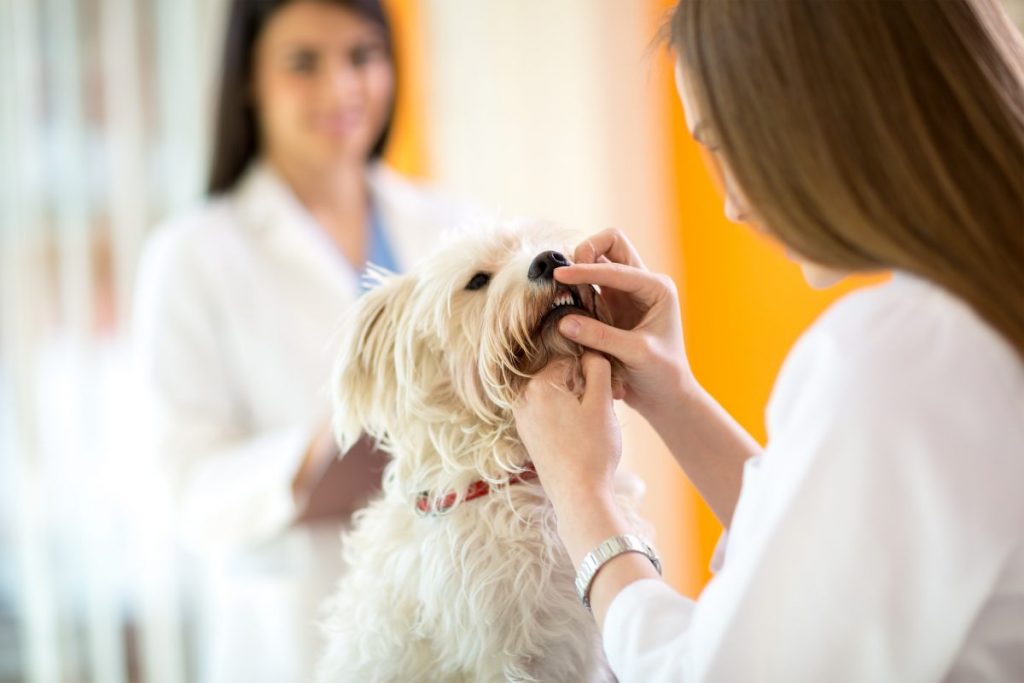From shots and vaccinations to deworming, maintaining your dog’s health and happiness involves so many different elements that it’s easy to forget about your pup’s mouth. Too often, owners forget about canine dental health, which can lead to a variety of potential problems.
Periodontal disease is one of the most common health problem found in pets. According to the American Veterinary Medical Association, an estimated 80 percent of dogs will have some form of periodontal disease by the age of two. Periodontal disease can pose some serious health problems, interfering with your dog’s general wellbeing and livelihood.
Read on to learn more about gum disease in dogs, its causes, and some simple steps you can take to prevent it.
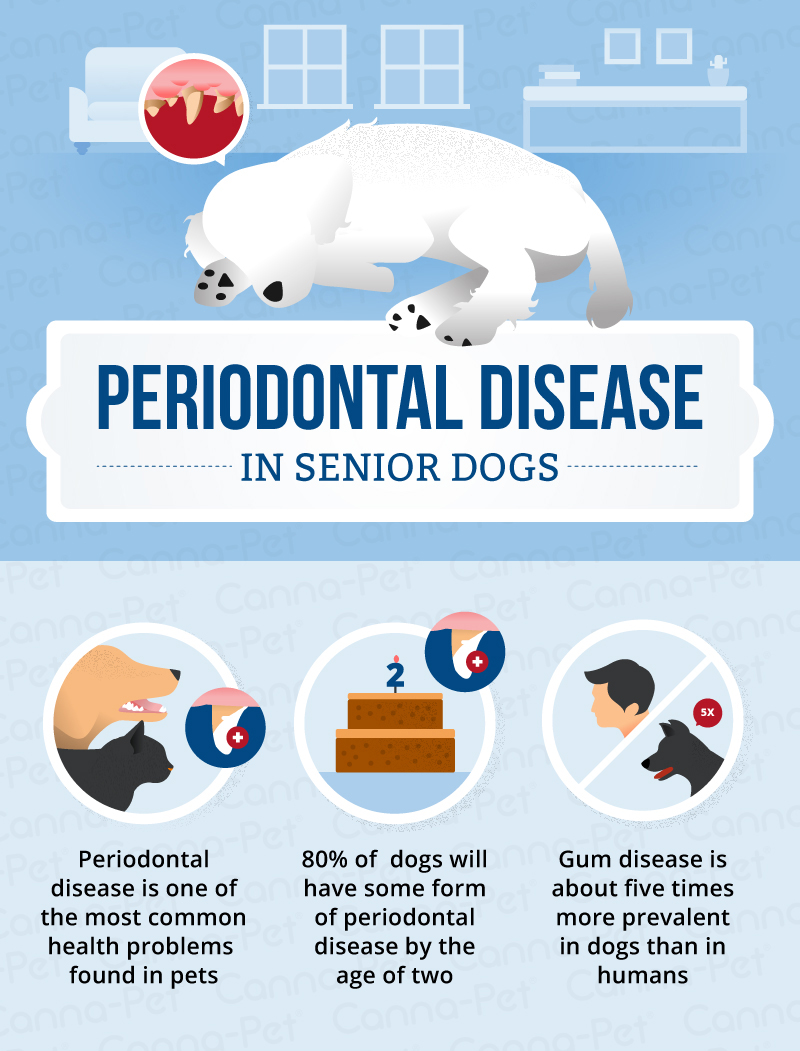
What is Periodontal Disease?
Periodontal disease affects the areas around your dog’s teeth, including the gums, soft tissues, and even the jaw bones. It is a bacterial infection that exhibits itself in four stages:
- Stage 1: Gums that are mildly inflamed with no separation of gum and tooth
- Stage 2: A 25 percent connective tissue attachment loss
- Stage 3: 25 to 30 percent connective tissue attachment loss
- Stage 4: Known as advanced periodontitis, involves over 50 percent connective tissue attachment loss, receding gums, and exposed roots of the teeth
Gum disease is about five times more prevalent in dogs than humans thanks to the chemical make up of a dog’s mouth and saliva. In addition, dog mouths are more alkaline, allowing for greater plaque formation.

What Causes Periodontal Disease in Dogs?
The main cause of periodontal disease in dogs (and humans) is bacteria. The most common culprits are Actinomycesi and Streptococcus. As soon as your dog eats something, the bacteria break down the food, saliva, and other particles to form a thick film over the teeth. This is known as plaque.
Plaque does a lot of things, like give the bacteria a nice environment to multiply and thrive. It can also mix with the minerals in saliva to form dental calculus, which you might simply know as tartar. Tartar is harder to remove than plaque, firmly affixing itself to your pup’s teeth, but tartar itself is not a sign of periodontal disease.
Most significantly, plaque is considered foreign by your dog’s immune system. When your dog’s body notices foreign invaders, it sends in white blood cells to try to remove or neutralize the plaque bacteria to maintain good health.
The bacteria living within the plaque then signal the white blood cells to release enzymes that break down the gums. This gradual breakdown can eventually work its way into the soft tissues and bones around your dog’s mouth.
Symptoms of Canine Periodontal Disease
Most of the time, pet owners don’t realize that their dogs have periodontal disease until it has progressed to an advanced stage. This is mainly because the first symptoms are hard to spot. Recognizing the signs of periodontal disease is made even harder by the fact that some dogs will instinctively try to hide any pain or discomfort to avoid showing weakness.
If you are actively checking your dog’s teeth and oral health, the first noticeable sign should be inflamed, red, swollen gums. In addition to this, one of the earliest signs of periodontal disease is sudden and exceptional bad breath. Your dog’s teeth may also appear yellow or brown. In more extreme cases, you may notice that your dog has loose teeth or even be missing teeth entirely.
Some other common signs of periodontal disease include:
- Bleeding gums
- Blood in water bowls or on chew toys
- Bloody, ropey saliva
- Making noises or “talking” when your dog yawns or eats
- Not wanting to be touched on the head (also known as head shyness)
- Lumps in your dog’s mouth
- Chewing one side of the mouth
Periodontal disease does not just entail bad teeth and gums. The pain can be so bad that your dog may not be able to eat or chew, leading to a loss of appetite and unhealthy weight loss. Advanced periodontal disease can spread to the bone separating the oral and nasal cavities, completely destroying it. This can lead to frequent sneezing and nasal discharge.

The most common complication coming from periodontal disease is pathologic jaw fracture. When left untreated, periodontal disease weakens a dog’s jaw bones to the point where even the smallest amount of pressure could lead to a complete fracture.
Along with gum and mouth problems, periodontal disease that is left untreated can lead to a higher risk of:
- Heart disease
- Kidney disease
- Liver problems
Risk Factors of Periodontal Disease in Dogs
Age is one of the biggest risk factors for periodontal disease in dogs. Older canines have a much higher chance of suffering from dental problems in general. This is not to say that younger pups are immune. Periodontal disease can affect dogs of any age.
Some breeds also have a higher chance than others. Generally, small breeds, toy breeds, and pug-nosed dogs have crowded teeth, which can put them at risk for periodontal disease. Some of these breeds include:
- Miniature Poodles
- Teacup Poodles
- Pugs
- Boston Terriers
- Pekingese
- Yorkshire Terriers
- Bichon Frises
- Chihuahuas
Grooming habits can also affect a dog’s chances of periodontal disease. Hair can accumulate around the teeth, while excessive grooming can cause tooth impaction. Both can increase the amount of tartar that builds up.
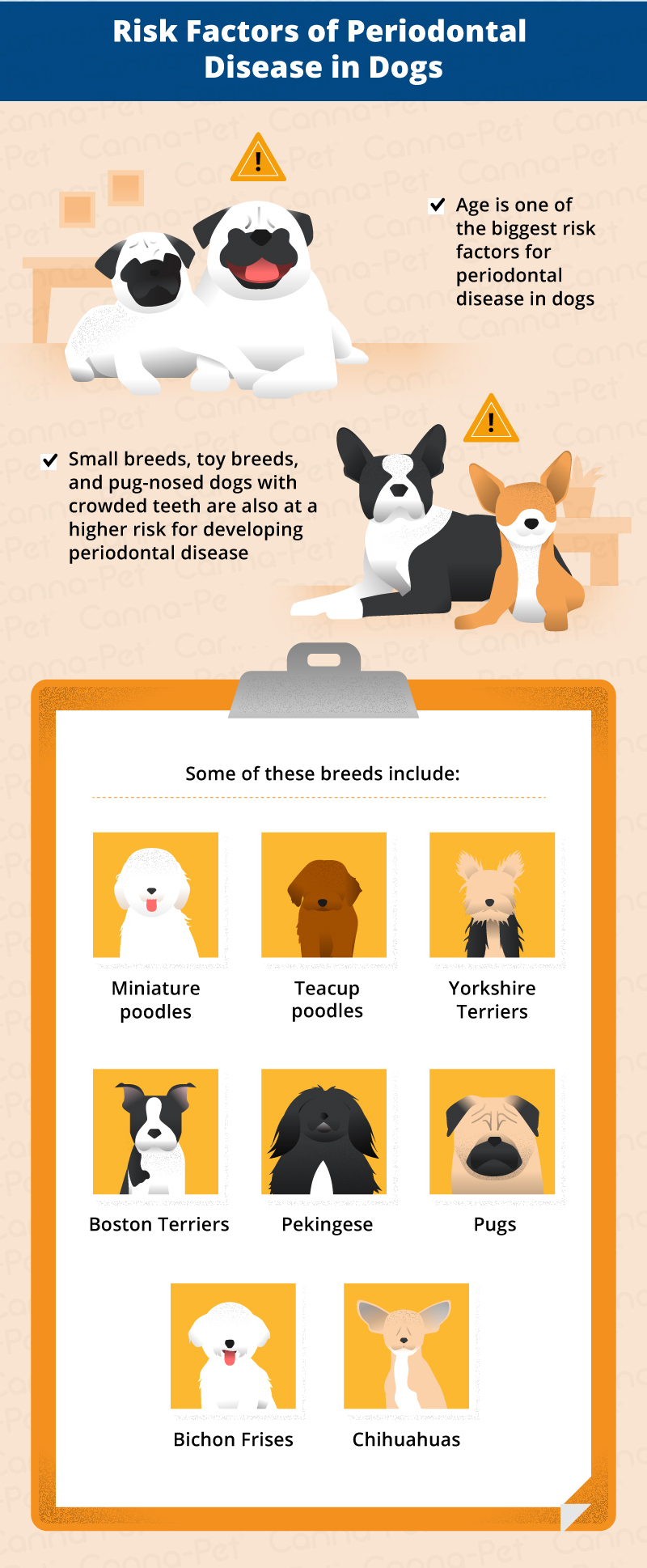
Diagnosing Canine Periodontal Disease
If you suspect your pup might be suffering from periodontal disease, a vet can conduct a variety of tests to better diagnose the condition. Most often, if simple periodontal probing shows more than two millimeters of space between the tooth and the gums, your dog is considered to have some form of periodontal disease.
From there, your vet can use x-rays to get a better idea of the disease’s severity. X-rays play an important role because 60 percent of the symptoms of periodontal disease are hidden under the gum line. Through x-rays, your vet can determine what stage the disease has progressed to.
In early stages, periodontal disease shows reduced sharpness and density in the root socket margin. As the disease progresses to its advanced stages, x-rays may show reduced bone support around the roots of infected teeth.
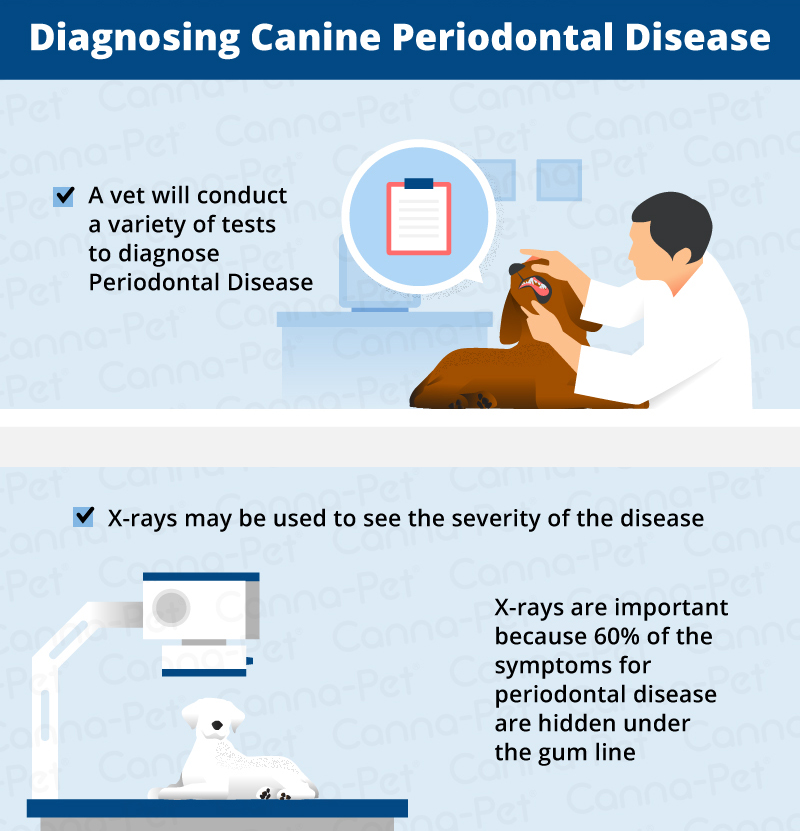
Treatments for Canine Periodontal Disease
Thankfully, once the disease has been diagnosed, vets can provide effective treatments for periodontal disease. The mode of treatment often depends on the extent of the disease and how much it has spread.
- If the disease is found in stage 1, treatment consists entirely of a thorough cleaning above and below the gum line. Sadly, most cases of periodontal disease in dogs progress far beyond this point.
- In stage 2, vets will clean and rinse the gum tissue and tooth roots. They will then apply an antibiotic gel to help the gums reattach to the roots of the tooth, reduce the size of the space, and rejuvenate gum tissue.
- By stage 3, the disease has spread deeper than 5 millimeters, indicating potential bone loss. Vets can open a gum flap and remove the diseased tissue surrounding the tooth root and gums. From there, they can regrow new tissue and bone through various special therapies.
- By stage 4, bone loss has exceeded 50 percent. Extracting the tooth is the only treatment at this point. This can also include bone replacement, guided tissue regeneration, and bone splinting.
The prognosis for periodontal disease is generally good, though it depends on what stage that periodontal disease has reached, which is why you should try to see your vet as soon as you notice something is wrong.
Follow-up treatment involves regular check-ups and more intensive dental care at home. Your vet may also recommend antibiotics for the first few weeks following treatment. Alternately, your vet may suggest pulse therapy, wherein your dog will receive antibiotics the first five days of every month, to lower the amount of harmful bacteria in your dog’s mouth.
Post-treatment, your vet may instruct you to provide your dog with only soft foods for a week, followed by a specialized dry diet to keep down plaque and tartar buildup.

How You Can Prevent Periodontal Disease in Your Dog
Preventing periodontal disease in your dog is fairly easy and can help him live happy, healthy, tail-wagging days. Some tips for preventing periodontal disease:
- Keeping your own teeth healthy starts with brushing daily, and the same applies to your pup. Brush your dog’s teeth at least twice a day. Minimizing bacteria and what they produce is often enough to ensure good health as your dog has its own internal defenses to battle infection and maintain a healthy mouth. Granted, brushing your dog’s teeth can be difficult at first, but with a little patience and the right tools, it will get much easier. With time, your dog should allow you to brush his teeth without much trouble. Consult your veterinarian if you need any guidance.
- Take your dog to the vet for regular cleanings and dental exams. Some teeth cleanings do not use anesthesia, which generally points to them being more cosmetic than medical. Oral exams must be performed with x-rays and general anesthesia to get a complete picture of what is happening below the gum line and within your dog’s teeth.
- Feed your dog good food. Your dog may benefit from dental foods that can scrub their teeth while they chew. Other foods contain natural or chemical additives that keep plaque from hardening on the teeth and gums. Talk to your vet for recommendations for the best food and supplements for your dog’s oral health.
- On top of high quality food, provide your dog with safe toys and treats for daily chewing. Chewing can help prevent gum disease by removing plaque and other debris while getting your dog to salivate more to wash away bacteria. Some treats are specifically designed to scrub your dog’s teeth, though remember that nothing replaces scrubbing with a toothbrush. Find toys that aren’t hard, like rubber balls, rubbery toys that can hold treats, and thin, pliant rawhide strips.
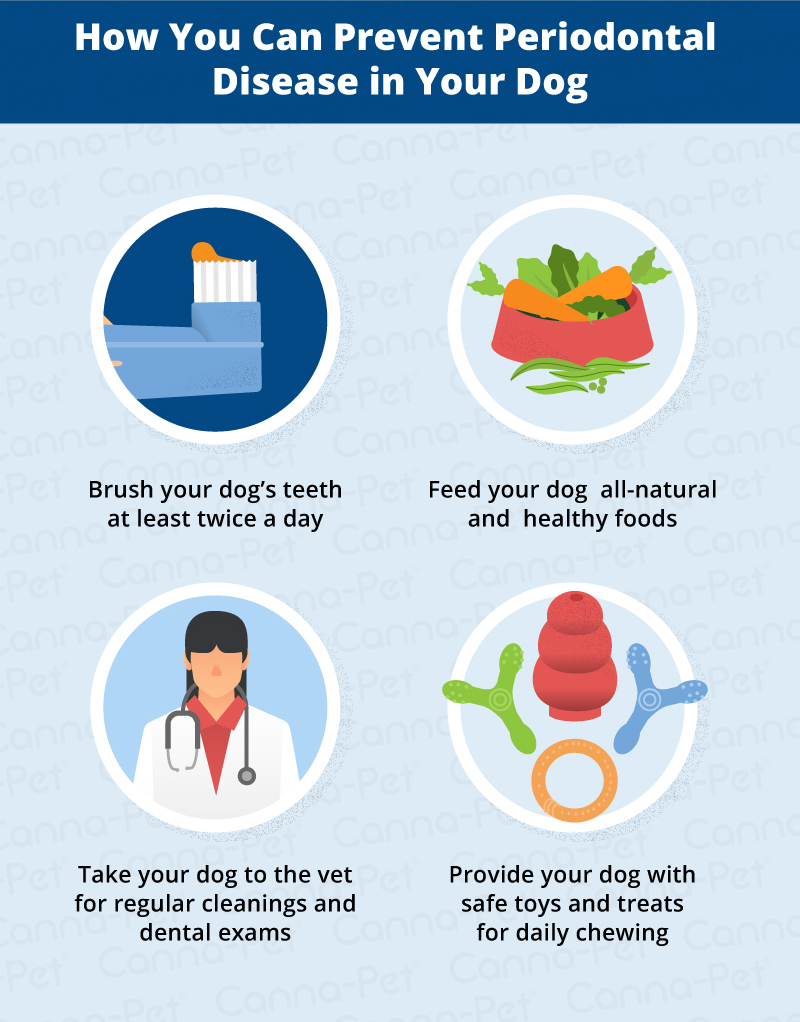
Harder rawhide can present gastrointestinal problems when swallowed. Avoid other hard treats and toys, including cow hooves, any animal bones (cooked and raw), and nylon bones. These can cause fractures, break teeth, and cause bleeding gums, which can lead to infection.
Taking care of your dog’s dental health will not only make for a brighter smile and fresher breath, but also increase your pup’s lifespan and quality of life.
Sources:
- “Dental Health in Older Dogs.” Dog Quality, Accessed 28 Jan. 2017. www.dogquality.com/blogs/senior-dog-blog/13922195-dental-health-in-older-dogs.
- Fries, Wendy C. “The Perils of Gum Disease in Dogs.” WebMD, Accessed 28 Jan. 2017. www.pets.webmd.com/dogs/features/perlis-gum-disease-dogs#1.
- “Oral Disease Treatment in Aging Dogs and Cats.” Healthy Pets, Accessed 28 Jan. 2017. www.healthypets.mercola.com/sites/healthypets/archive/2012/11/28/oral-disease.aspx.
- Pavia, Audrey. “Senior Dog Teeth Issues and How to Prevent and Care For Them.” Dogster, 28 Feb. 2018, Accessed 28 Jan. 2017. www.dogster.com/dog-health-care/senior-dog-teeth-issues-and-how-to-prevent-and-care-for-them.
- Farricelli, Adrienne. “Is My Dog Too Old for a Dental Cleaning?” PetHelpful, 27 Sept. 2016, Accessed 28 Jan. 2017. www.pethelpful.com/dogs/Is-My-Dog-Too-Old-for-a-Dental-Cleaning.

